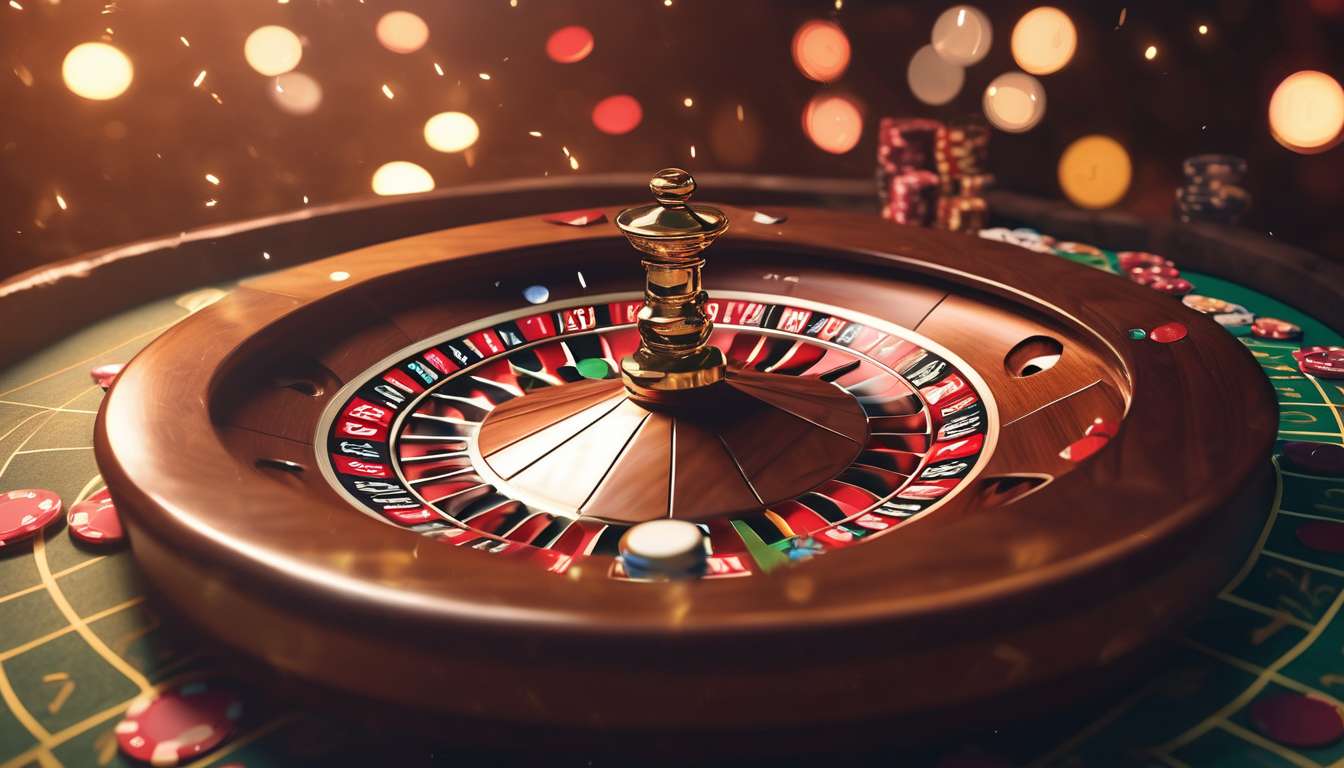As avid enthusiasts of the casino world, we understand the thrill of the spin, the deal, and the roll. The allure of the casino isn’t just in the games themselves but in the numbers that drive them.
Behind every slot machine, poker hand, and roulette spin lies a set of statistics that can make or break our night. These essential statistics are the backbone of any seasoned player’s strategy and the key to understanding:
- House edge
- Payout percentages
- Odds of success
By delving into these numbers, we not only enhance our gaming experience but also arm ourselves with the knowledge to make informed decisions and maximize our enjoyment.
Whether we’re seasoned players or newcomers to the casino floor, these statistics are our allies in navigating the complex and exciting world of gambling.
Join us as we explore these critical figures that every casino enthusiast should know and understand.
Understanding House Edge
The House Edge
The house edge is the casino’s built-in advantage over players, ensuring they make a profit over the long term. This concept highlights that winning is not solely reliant on luck, but also on a mathematical certainty embedded in each game. Understanding the house edge helps us appreciate how casinos thrive and allows us to feel more connected and informed as gaming enthusiasts.
Unique House Edges for Different Games
Each game in a casino comes with its unique house edge, which directly affects potential winnings. For example, if a game has a house edge of 5%, this implies that the casino expects to retain 5% of every dollar bet over time.
Return to Player (RTP)
- The Return to Player (RTP) is the opposite concept, indicating the percentage of wagered money that a player might expect to win back.
- Games with lower house edges typically offer higher RTPs, appealing to savvy players keen on maximizing their returns.
Variance and Game Experience
Variance, or the game’s risk level, also plays a crucial role in shaping the gaming experience. It affects how wins and losses fluctuate, thereby influencing a player’s overall satisfaction and strategy.
By understanding these elements, players enhance their gaming experience and sense of belonging within the community of knowledgeable and strategic gamers.
Cracking Payout Percentages
Payout Percentages and Return to Player (RTP)
By diving into payout percentages, we gain a clearer understanding of how casinos determine the amount players can potentially win back from their wagers. Payout percentages are crucial in our shared quest for informed gambling.
They tell us the Return to Player (RTP) value, which reveals how much a game is expected to pay back over time.
- For example, an RTP of 95% means that for every $100 wagered, we could expect to win back $95, while the remaining $5 represents the House Edge that the casino keeps.
Variance: Understanding Game Risk
Variance, another key term, refers to the game’s risk level.
- High variance games mean bigger wins but less frequently.
- Low variance games offer smaller, more consistent payouts.
Making Informed Choices
By understanding these concepts, we can make choices that align with our gaming preferences. Together, as a community of enthusiasts, we can use this knowledge to enhance our experiences and share in the thrill of the game with confidence.
Mastering Odds of Success
Understanding the Odds of Success
Understanding the odds of success allows us to strategically choose games that match our risk appetite and potential reward. Navigating the casino landscape can feel overwhelming, but by mastering concepts like House Edge, Return to Player, and Variance, we gain a sense of belonging within the gaming community.
House Edge
- The House Edge represents the casino’s advantage, a crucial factor as we decide which games to play.
- Opting for games with a lower House Edge can increase our chances of success.
Return to Player (RTP)
- RTP indicates the percentage of wagered money a game returns to players over time.
- A higher RTP suggests better odds for us.
Variance
- Understanding Variance helps us manage expectations.
- Low variance games offer frequent, smaller wins, ideal for those seeking steady play.
- High variance games deliver larger payouts, but less often, catering to our thrill-seeking side.
By mastering these odds, we’re better equipped to enjoy our casino experience.
Decoding Return to Player (RTP)
The Importance of Return to Player (RTP) Percentage
The Return to Player (RTP) percentage is a critical factor in selecting games that align with our gaming goals. It indicates the portion of our total bets we can expect to get back over time.
For example, if a game has an RTP of 96%, it theoretically means we should receive $96 for every $100 wagered.
Understanding the House Edge
The House Edge is essentially the casino’s advantage and is calculated as 100% minus the RTP.
- If a game has a 4% House Edge, it means the casino keeps $4 of every $100 bet.
Role of Variance
Variance affects win frequency and payout size. It’s crucial to choose games with the right balance of RTP and House Edge to suit our risk appetite.
By understanding variance, we can ensure our gaming experience is both enjoyable and rewarding.
Making Informed Choices
Understanding the interplay between RTP, House Edge, and Variance helps us feel more connected to the game. It allows us to make informed choices that align with our personal gaming goals and risk preferences.
By selecting games wisely, we can enhance our overall gaming experience.
Grasping Variance and Volatility
In exploring the concepts of variance and volatility, we’ll uncover how they shape the unpredictability and excitement of our gaming experiences.
Variance refers to the fluctuations in our game outcomes, influencing how often and how much we might win or lose.
- When we embrace games with high variance, we’re chasing those thrilling, albeit less frequent, big wins.
- Conversely, low variance games offer more consistent, smaller wins, creating a steadier gaming rhythm.
Volatility is closely tied to variance and similarly affects our gaming journey.
- High volatility means more rollercoaster rides of big wins and losses.
- Low volatility offers smoother sailing.
Understanding these dynamics helps us balance our thrill-seeking with sensible play.
Let’s not forget the House Edge and Return to Player (RTP) percentages. They provide insights into how variance and volatility affect our long-term experiences.
By grasping these concepts, we’re better equipped to choose games that match our personal gaming style and community spirit.
Analyzing Hit Frequency
Understanding Hit Frequency
Hit frequency helps us gauge how often we can expect to win during our gaming sessions. It’s about feeling connected to the rhythm of the game and knowing when it might favor us.
In slot machines, for example, a higher hit frequency means more frequent, albeit smaller, wins. This knowledge helps us feel more at home among fellow enthusiasts who appreciate the nuances of the game.
Connection to House Edge and RTP
Hit frequency is closely tied to the House Edge and Return to Player (RTP):
- House Edge: Indicates the casino’s advantage.
- RTP: Shows the percentage of our wagered money we might win back over time.
Games with high hit frequency tend to have lower variance, providing a steadier flow of wins.
Strategic Gaming Choices
Understanding how hit frequency interacts with the House Edge and RTP enables us to:
- Choose games that fit our play style.
- Seek camaraderie with others who share our passion for strategic gaming.
Unveiling Expected Value (EV)
Expected Value (EV) gives us a powerful tool to predict the average outcome of our bets over time. By understanding EV, we, as a community of casino enthusiasts, gain insight into how different games reward us and how often.
EV works hand-in-hand with concepts like House Edge and Return to Player (RTP):
- House Edge represents the casino’s advantage.
- RTP tells us how much of our wagered money is returned to us over time.
When we embrace the EV concept, we start to see the bigger picture of our gaming experiences.
Knowing the variance, or the fluctuation in our game’s results, lets us anticipate the ups and downs without losing our cool. We find comfort in the numbers, knowing we’re making informed choices.
Together, we delve deeper, understanding these statistics not just as numbers but as keys to enjoying our shared passion for casino games responsibly and with camaraderie.
Exploring Risk vs. Reward
In our journey through casino games, we constantly weigh the potential rewards against the inherent risks, striving to make informed decisions that enhance our enjoyment and success. We become part of a community that understands the importance of assessing the House Edge, a critical factor that indicates the advantage the casino holds over us. By acknowledging this, we can make smarter choices about which games to play.
Let’s also consider the Return to Player (RTP) percentage, which tells us how much of our wagered money we can expect to win back over time. A higher RTP means a better chance of seeing returns, bringing us closer to the camaraderie of shared success.
Variance, on the other hand, describes the volatility of a game. Understanding these dynamics helps us balance risk and reward, ensuring our gaming experience feels both thrilling and inclusive.
- High variance games may offer substantial wins but less frequently.
- Low variance games provide smaller, more consistent payouts.
By considering these factors, we can ensure a more enjoyable and strategic gaming experience.
What are the psychological effects of gambling on regular casino-goers?
When we think about the psychological effects of gambling on regular casino-goers, it’s important to consider how it can impact their mental well-being.
The thrill of winning can be addictive, leading to:
- Increased risk-taking behavior
- Potential financial strain
Moreover, the highs and lows of gambling can trigger intense emotions such as:
- Excitement
- Anxiety
- Disappointment
These emotional fluctuations can significantly affect overall mental health.
Understanding these dynamics is crucial in promoting responsible gambling practices.
How do casinos use technology to ensure fair play and security?
Casinos use technology to ensure fair play and security through several key methods:
-
Advanced Surveillance Systems:
- These systems monitor gaming activities in real-time.
- They track everything from card shuffling to payouts.
- The goal is to ensure that no foul play occurs.
-
Biometric Technology:
- Used to verify the identities of both players and employees.
- Enhances overall security measures.
By combining these technological advancements, casinos create a safe and fair gaming environment for all patrons.
What are the most common myths and misconceptions about casinos?
Myth 1: Casinos Can Manipulate Slot Machines to Control Payouts
Many people believe that casinos have the ability to alter slot machines to change the odds of winning. However, this is a misconception.
- Slot machines are regulated by gaming commissions and use random number generators (RNGs) to ensure fairness.
- The odds are predetermined and cannot be changed by the casino on a whim.
Myth 2: Card Counting in Blackjack is Illegal
Another common myth is that card counting is against the law. In reality, card counting is a legal strategy used by players to gain an advantage.
- While not illegal, casinos may ask players suspected of counting to leave, as it is against their house rules.
- Casinos are private establishments and can enforce rules to protect their interests.
Importance of Understanding Casino Regulations
To enjoy gambling responsibly, it’s crucial to be informed about the regulations that govern casino operations:
-
Regulatory Bodies: Casinos are subject to oversight by government bodies to ensure games are fair and transparent.
-
Licensing: Casinos must obtain licenses that require adherence to strict operational standards.
-
Fair Play: Regular audits and checks are conducted to maintain integrity and fairness in all games.
Conclusion
By educating ourselves about how casinos operate and the laws in place, we can enjoy gambling responsibly and dispel common myths and misconceptions. This knowledge helps us appreciate the true nature of casino entertainment and the efforts made to ensure a fair gaming environment.
Conclusion
Now that you’ve delved into these essential casino statistics, you’re equipped to make more informed decisions while enjoying your favorite games.
Key Concepts to Remember:
-
House Edge: This is the mathematical advantage that the casino has over players. It varies for each game and is crucial for understanding potential losses over time.
-
Payout Percentages: This indicates the average amount a player can expect to win back from their wagers over time. Higher payout percentages suggest better chances for the player.
-
Odds of Success: Understanding the odds can help you determine the likelihood of winning a particular game or bet.
By understanding these concepts, you can enhance your overall gaming experience. Remember to keep these key statistics in mind next time you hit the casino floor.
May your understanding of risk versus reward guide you towards success.
Happy gaming!




